PEDIATRICS - HESI PRACTICE EXAM
Document Content and Description Below
PEDIATRICS - HESI PRACTICE EXAM 1. A preschool-age child who is hospitalized for hypospadias repair is most strongly influenced by which behavior? A. ability to communicate verbally B. respons... e to separation from family C. concern for body integrity D. socialization with other children RATIONALE: The preschooler's major stressor is concern for his body integrity. He fears that his "insides will leak out". A child undergoing surgery to his genitalia is even more concerned about body integrity. the preschooler is quite verbal so comprehension of the words he uses or hears may be inaccurate, while his imagination and fears may fantasize the reality. (B) is a concern for all children, but of most concern to the toddler. (D) is not a prime concern in this situation. 2. An infant is born with a ventricular septal defect (VSD) and surgery is planned to correct the defect. The nurse recognizes that surgical correction is designed to achieve which outcome? A. stop the flow of unoxygenated blood into systemic circulation B. increase the flow of unoxygenated blood to the lungs. C. prevent the return of oxygenated blood to the lungs. D. reduce peripheral tissue hypoxia and nailbed clubbing. RATIONALE: Closure of VSDs stops oxygenated blood from being shunted from the left ventricle to the right ventricle. VSDs are acyanotic defects, which means that no unoxygenated blood enters the systemic circulation. (D) is common with Tetrology of Fallot, which is a cyanotic defect. 3. A three-month old boy weighing 10 lbs, 15 oz has an axillary temperature of 98.9 degrees F. The nurse determines the daily caloric need for this child is approximately: A. 400 cal/day B. 500 cal/day C. 600 cal/day D. 700 cal/day RATIONALE: 1 4. The nurse is preparing a health teaching program for parents of toddlers and preschoolers and plans to include information about prevention of accidental poisonings. It is most important for the nurse to include which instructions? A. tell children they should not taste anything but food B. store all toxic agents and medicines in locked cabinets. C. Provide special play areas in the house and restrict play in other areas. D. punish children i they open cabinets that contain household chemicals. 5. A 6-month old infant with congestive heart failure (CHF) is receiving digoxin elixer. Which observation by the nurse warrants immediate intervention? A. apical heart rate of 60. B. sweating across the forehead C. doesn't suck well D. respiratory rate of 30 breaths/minute RATIONALE: 6. At 8am, the unlicensed assistive personnel (UAP) informs the charge nurse that a female adolescent client with acute glomerulonephritis has a blood pressure of 210/110. The 4am BP reading was 170/88. The client reports to the UAP that she is upset because her boyfriend did not visit last night. What action should the nurse take? A. give the client her 9am prescription for an oral diuretic early. B. administer PRN prescription of nifedipine (Procardia) sublingually. C. notify the healthcare provider and inform the nursing supervisor of the client's condition D. attempt to calm the client and retake the BP in 30 minutes. RATIONALE: 7. A premature newborn girl, born 24 hours ago, is diagnosed with a patent ductus arteriosus (PDA) and placed under an oxygen hood at 35%. The parents visit the nursery and ask to hold her. Which response should the nurse provide to the parents? A. Studies have shown that handling a sick newborn is not good for the baby and upsets the parents. B. the oxygen hood is holding the baby's oxygen level just at the point which is needed. You may stroke and talk to her. C. Since your baby has been doing well under oxygen for 24 hours, I can let you hold the baby without oxygen. D. You can hold the baby with the oxygen blowing on the baby's face since the level is very close to room air. RATIONALE: 8. The nurse is developing a plan of care for a 3-year old who is scheduled for a cardiac catheterization. To assist in decreasing anxiety for the child on the day of the procedure, which intervention is best for the nurse to implement? A. Reassure the parents that 3-year old’s are cooperative and therefore are less likely to be anxious. B. Obtain a video film of a cardiac catheterization to show to the child prior to the procedure C. give the child a ride on a gurney to visit the cardiac catheterization lab and meet a nurse who works there. D. Obtain a cardiac catheter and demonstrate the procedure by pretending to put the catheter in a doll or stuffed animal. RATIONALE: 9. When taking the health history of a child, the nurse knows that which finding is an early indication of hypothyroidism in children? A. hyperactive behavioral traits B. delay in the eruption of permanent teeth C. slow sexual development but within normal range D. cessation of growth in a child that had been normal. RATIONALE: 10. The nurse is teaching a 12-year old male adolescent and his family about taking injections of growth hormone for idiopathic hypopituitarism. Which adverse symptoms, commonly associated with growth hormone therapy should the nurse plan to describe to the child and his family? A. polyuria and polydipsia B. lethargy and fatigue C. increased facial hair D. facial bone structure changes RATIONALE: 11. The nurse is caring for a 12-year old with Syndrome of Inappropriate Antidiuretic Hormone (SIADH). This child should be carefully assessed for which complication? A. poor skin turgor resulting from dehydration B. changes in LOC C. premature aging as the disease progresses D. severe edema from an excess of water and sodium RATIONALE: 12. A four-year old girl continues to interrupt her mother during a routine clinic visit. the mother appears irritated with the child and asks the nurse, "Is this normal behavior for a child this age?" The nurse's response should be based on which information? A. children need to retain a sense of initiative without impinging on the rights and privileges of others. B. negative feelings of doubt and shame are characteristic of 4-year-old children C. Role conflict is a common problem of children this age. She is just wondering where she fits into society. D. At this age children compete and like to produce and carry through with tasks. She is just competing with her mother. RATIONALE: 13. a 14-year old female client tells the nurse that she is concerned about the acne she has recently developed. Which recommendation should the nurse provide? A. Remove all blackheads and follow with an alcohol scrub B. Use medicated cosmetics only to help hide the blemishes. C. Wash the hair and skin frequently with soap and hot water. D. Encourage her to see a dermatologist as soon as possible. RATIONALE: 14. The mother of a 2-year old boy consults the nurse about her son's increased temper tantrums. The mother states, "Yesterday he threw a fit in the grocery store, and I did not know what to do. I was embarrassed. What can I do if this occurs again?" Which recommendation is best for the nurse to provide this mother? A. paddle him gently as soon as the behavior is initiated B. immediately put him in "time-out" C. quietly remind him that others are watching him D. walk away from him and ignore the behavior RATIONALE: 15. During discharge teaching of a child with juvenile rheumatoid arthritis, the nurse should stress to the parents the importance of obtaining which diagnostic testing? A. hearing test B. eye exam C. chest x-ray D. fasting blood glucose test RATIONALE: 16. A hospitalized 16-year old male refuses all visits from his classmates because he is concerned about his distorted appearance. To increase the client's social interaction, what intervention is best for the nurse to initiate? A. encourage the client to use a hand-held video game that is popular with all his friends B. assign a 25-year-old female nursing student to offer support to the client C. arrange for an internet connection in the client's room for email communication D. encourage the client's mother to arrange a surprise get together in the cafeteria. RATIONALE: 17. The nurse is assessing a 2-year old. What behavior indicates that the child's language development is within normal limits? A. Is able to name four colors B. can count five blocks C. is capable of making a three-word sentence D. half of child's speech is understandable. RATIONALE: 18. When evaluating the effectiveness of interventions to improve the nutritional status of an infant with gastro-esophageal reflux, which intervention is most important for the nurse to implement? A. record weight daily B. assess for signs of anemia C. document sleeping patterns D. teach parenting skills RATIONALE: 19. Which menu selection by a child with celiac disease indicates to the nurse that the child understands necessary dietary considerations? A. oven-baked potato chips and cola. B. peanut butter and banana sandwich C. oatmeal-raisin cookies and milk D. graham crackers and fruit juice RATIONALE: 20. The parents of a 3-week old infant report that the child eats well but vomits after each feeding. what information is most important for the nurse to obtain? A. description of vomiting episodes in the past 24 hours B. number of wet diapers in last 24 hours C. feeding and sleep schedule D. amount of formula consumed during the past 24 hours RATIONALE: 21. A 3-month old infant develops oral thrush. Which pharmacologic agent should the nurse plan to administer for treatment of this disorder? A. Nystantin (Mycostatin) B. Nitroflurantoin (Macrodantin) C. Norfloxacin (Noroxin) D. Neomycin sulfate (Mycifradin) RATIONALE: 22. Which class of anti-infective drugs is contraindicated for use in children under 8 years of age? A. aminoglycosides B. tetracyclines C. penicillins D. quinolones RATIONALE: 23. A female teenager is taking oral tetracycline HCL (Achromycin V) for acne vulgaris. What is the most important instruction for the nurse to include in this client's teaching plan? A. Use sunscreen when lying by the pool. B. cleanse the skin at least 4 times a day. C. take the medication with a glass of milk D. menstrual periods may become irregular RATIONALE: 24. The mother of a 6-month old asks the nurse when her baby will get the first measles, mumps, and rubella (MMR) vaccine. Based on the recommended childhood immunization schedule published by the Centers for Disease Control, which response is accurate? A. 3-6 months B. 12-15 months C. 18-24 months D. 4-6 years RATIONALE: 25. Preoperative nursing care for a child with Wilm's tumor should include which intervention? A. gently percuss the abdomen for evidence of trapped air B. observe the abdomen for any noticeable discolorations C. apply cold compresses to the abdomen to reduce edema D. Put a sign on the bed reading, "DO NOT PALPATE ABDOMEN." RATIONALE: 26. A 4-year old boy was admitted to the emergency room with a fractured right ulna and a short arm cast was applied. When preparing the parents to take the child home, which discharge instruction has the highest priority? A. call the healthcare provider immediately if his nail beds appear blue. B. check his fingers hourly for the first 48 hours to see that he is able to move them without pain. C. Be sure your child's arm remains above his heart for the first 24 hours. D. Take his temperature every four hours for the next two days and call if an elevation is noted. RATIONALE: 27. An 18-month old is admitted to the hospital with possible Hirschsprung's disease. When obtaining a nursing history, the nurse asks about bowel habits. What describes the disease? A. foul-smelling and fatty B. bile-colored and watery C. semi-solid and yellow D. ribbon-like and brown RATIONALE: 28. The nurse must prevent a 2-year old with severe eczema on the face, neck and scalp from scratching the affected areas. Which nursing intervention is most effective in preventing further excoriation due to the pruritis? A. obtain gloves for the child's hands B. apply finger cots on the child's fingers C. place elbow restraints on the child's arms D. apply soft restraints to the child's wrists RATIONALE: 29. The nurse assigning care for a 5-year old with otitis media is concerned about the child's increasing temperature over the past 24 hours. Which statement is accurate and should be considered when planning care for the remainder of the shift? A. An RN should be assigned to take temperatures frequently. B. tympanic and oral temperatures are equally accurate C. the PN should take rectal temperatures on this child. D. The pediatrician should decide how to assess the temperature RATIONALE: 30. A 3-year old boy is brought to the emergency room because he swallowed an entire bottle of children's vitamin pills. Which intervention should the nurse implement first? A. insert NG tube for gastric lavage B. determine the child's pulse and respirations C. assess the child's LOC D. administer an IV D5/0.25 NS as prescribed RATIONALE: 31. A 2-year old with gastro-esophageal reflux has developed a fear of eating. What instruction should the nurse include in the parents' teaching plan? A. invite other children home to share meals B. accept that he will eat when he is hungry C. reward the child with a nap after eating D. consistently follow a set mealtime routine. RATIONALE: 32. A 6-month old boy and his mother are at the healthcare provider's office for a well-baby checkup and routine immunizations. the healthcare provider recommends to the mother that the child receive an influenza vaccine. What medications should the nurse plan to administer today? A. The routine immunizations and schedule another appointment to administer the influenza vaccine B. All the immunizations with the influenza vaccine given at a separate site from any other injection. C. the influenza vaccine and schedule another appointment to administer the immunizations D. The influenza vaccine and the polio vaccine and schedule another appointment to administer the remaining immunizations. RATIONALE: 33. The nurse is assessing a 13-year old girl with suspected hyperthyroidism. Which question is most important for the nurse to ask her during the admission interview? A. Have you lost any weight in the last month? B. Are you experiencing any type of nervousness? C. When was the last time you took synthroid? D. Are you having any problems with your vision? RATIONALE: 34. The nurse is planning care for school aged children at a community care center. Which activity is best for the children? A. building model airplanes B. playing follow-the-leader C. stringing large and small beads D. Playing with playdough and clay RATIONALE: 35. Surgery is being delayed for an infant with undescended testes. In collaboration with the healthcare provider and the family, which prescription should the nurse anticipate? A. a trial of adrenocorticotropic hormone injections B. Frequent stimulation of the cremasteric reflex C. a trial of human chorionic gonadotrophic hormone D. frequent warm baths to gently dilate the scrotal area. RATIONALE: 36. A 3-year-old client with sickle cell anemia is admitted to the Emergency Department with abdominal pain. The nurse palpates an enlarged liver, an x-ray reveals an enlarged spleen, and a CBC reveals anemia. these findings indicate which type of crisis? A. Aplastic B. sequestration C. hyperhemolytic D. vaso-occlusive RATIONALE: 37. To assess the effectiveness of an analgesic administered to a 4-year-old, what intervention is best for the nurse to implement? A. use a happy face/sad face pain scale B. ask the mother if she thinks the analgesic is working C. assess for changes in the child's vital signs D. teach the child to point to a numeric pain scale RATIONALE: 38. In developing a teaching plan for a 5-year-old child with diabetes, which component of diabetic management should the nurse plan for the child to manage first? A. food planning and selection B. administering insulin injections C. process of glucose testing D. drawing up the correct insulin dose RATIONALE: 39. A 17-year-old male student reports to the school clinic one morning for a scheduled health exam. He tells the nurse that he just finished football practice and is on his way to class. The nurse assesses his vital signs: temperature 100F, pulse 80, respirations 20, and BP 122/82. What is the best action for the nurse to take? A. tell the student to proceed directly to his regularly scheduled class. B. call the parent and suggest re-taking the student's temperature at home C. give the student a glass of cool fluids, then retake his temperature D. send the student to class, but re-verify his temperature after lunch RATIONALE: 40. The vital signs of a 4-year-old child with polyuria are BP 80/40, pulse 118, and respirations 24. the child's pedal pulses are present with a volume of +1 and no edema is observed. What action should the nurse implement first? A. insert an indwelling urinary catheter B. start an IV infusion of normal saline C. send a specimen to the lab for urinalysis D. document the child's vital signs and pulses RATIONALE: 41. A 3-week-old newborn is brought to the clinic for follow after a home birth. the mother reports that her child bottle feeds for 5 minutes only and then falls asleep. the nurse auscultates a loud murmur characteristic of a ventricular septal defect (VSD) and finds the newborn is acyanotic with a respiratory rate of 64 breaths per minute. What instruction should the nurse provide the mother to ensure the infant is receiving adequate intake? (select all that apply) A. monitor the infant's weight and number of wet diapers per day. B. increase the infant's intake per feeding by 1-2 ounces per week C. Mix the dose of prophylactic antibiotic in a full bottle of formula D. allow the infant to rest and refeed on demand on every 2 hours E. use a softer nipple or increase the size of the nipple opening RATIONALE: 42. When discussing discipline with the mother of a 4-year-old child, the nurse should include which guideline? A. parental control should be consistent B. children as young as 4 years rarely need reprimand or punishment C. Withdrawal of approval is effective D. Parents should enforce rigid rules to be followed without question. RATIONALE: 43. Which action by the nurse is most helpful in communicating with a preschool-aged child? A. speak clearly and directly to the child B. use a doll to play and communicate C. approach when a parent is not present D. play a board game with the child. RATIONALE: 44. The nurse is having difficulty communicating with a hospitalized 6-year-old child. Which approach by the nurse is the most helpful in establishing communication? A. engage the child through drawing pictures B. suggest that the parent read a book to the child C. provide paper and pencil for the child to keep a diary D. ask the parent if the child is always uncommunicable RATIONALE: 45. A child falls on the playground and is brought to the school nurse with a small laceration on the forearm. Which action should the nurse implement first? A. slowly pour hydrogen peroxide over the open wound B. apply ice to the area before rinsing with cold water C. wash the wound gently with mild soap and water D. gently cleanse with a sterile pad using povidone-iodine RATIONALE: 46. A 6-year-old is admitted to the pediatric unit after falling off a bicycle. Which intervention should the nurse implement to assist the child's adjustment to hospitalization? A. explain hospital schedules to the child, such as mealtimes. B. use terms, such as "honey" and "dear" to show a caring attitude. C. provide a list of rules that limits visitation of siblings in the hospital D. orient the parents to the hospital unit and refreshment areas. RATIONALE: 47. A 16-year-old is brought to the emergency department with a crushed leg after falling off a horse. the adolescent's last tetanus toxoid booster was received eight year ago. What action should the nurse take? A. dispense a tetanus antitoxin B. prepare human tetanus immune globulin C. administer tetanus toxoid booster D. delay the tetanus toxoid booster until due RATIONALE: 48. A child with cystic fibrosis is having stools that float and are foul smelling. Which descriptive term should the nurse use to document the finding? A. diarrhea B. rhinorrhea C. galactorrhea D. steatorrhea RATIONALE: 49. The clinic nurse is taking the history for a new 6-month-old client. The mother reports that she took a great deal of aspirin while pregnant. Which assessment should the nurse obtain? A. type of reaction to loud noises B. any surgeries on the ears since birth C. drainage from the infant's ears D. number of ear infections since birth RATIONALE: 50. The nurse is giving a liquid iron preparation to a 3-year-old child. Which technique should the nurse implement to engage the child's cooperation? A. use a colorful straw B. mix the medication in water C. administer the medication using an oral syringe D. ask the pharmacy to provide an enteric tablet. RATIONALE: 51. The nurse is teaching a mother to give 4 mL of liquid antibiotic to a 10-month-old infant. Which statement by the parent indicates a need for further teaching? A. I will give this antibiotic to my child until it is finished B. using a teaspoon will help me measure this correctly. C. I will call the clinic if my child develops a rash or itching D. my baby should begin to eel better within a few days RATIONALE: 52. Which growth and development characteristic should the nurse consider when monitoring the effects of a topical medication for an infant? A. a lower sensitivity reaction to skin irritants B. a thin stratum corneum that increases topical absorption C. a smaller percentage of muscle mass D. a greater body surface area that requires larger doses RATIONALE: 53. A 2-year-old child recently diagnosed with hemophilia A is discharged home. What information should the nurse include in a teaching plan about home care? A. Minimize interactive play with other children to lessen chances for injury B. give low-dose children's chewable aspirin in orange flavor for joint discomfort C. use a firm and dry toothbrush to clean teeth at least twice per day D. apply pressure and ice for bleeding while elevating and resting the extremity. RATIONALE: 54. A nurse provides the parents with information on health maintenance for their child with sickle cell disease. Which information reflected by the parents indicates understanding of the child's care? A. daily iron supplements should be given B. plenty of fluids should be consumed daily C. immunizations should be delayed for a few years D. protective equipment should be worn for contact sports. RATIONALE: 55. The nurse reviews the latest laboratory results for a child who received chemotherapy last week and identifies a reduced neutrophil count. Which nursing diagnosis has the highest priority for this child? A. risk for infection B. risk for hemorrhage C. altered skin integrity D. disturbance in body image RATIONALE: 56. During administration of a blood transfusion, a child complains of chills, headache and nausea. Which action should the nurse implement? A. start another IV of dextrose solution and stay with the child B. continue the transfusion and monitor the child's vital signs C. stop the infusion immediately and notify the healthcare provider D. slow the transfusion and assess for cessation of symptoms RATIONALE: 57. The nurse is teaching the parents of a 5-year-old with cystic fibrosis about respiratory treatments. Which statement indicates to the nurse that the parents understand? A. perform postural drainage before starting aerosol therapy B. Give respiratory treatments when the child is coughing a lot C. Administer aerosol therapy followed by postural drainage before meals D. ensure respiratory therapy is done daily during any respiratory infection RATIONALE: 58. The nurse is assessing the neurovascular status of a child in Russell's traction. Which finding should the nurse report to the healthcare provider? A. pale bluish coloration of the toes B. skin is warm and dry to the touch C. toes are wiggled upon command D. capillary refill less than 3 seconds RATIONALE: 59. A child is rescued from a burning house and brought to the emergency room with partial-thickness burns on the face and chest. Which action should the nurse implement first? A. insert an indwelling urinary catheter B. administer IV pain medication C. collect blood specimen for laboratory studies D. assess the child's respiratory status. RATIONALE: 60. The mother of a 4-year-old child asks the nurse what she can do to help her other children cope with their sibling's repeated hospitalizations. Which is the best response that the nurse should offer? A. inform the parent that the child is too young to visit the hospital B. suggest that the child visit a grandmother until the sibling returns home. C. ask the mother if the child asks when the sibling will be discharged D. encourage the mother to have the children visit the hospitalized sibling. RATIONALE: 61. Which finding in a 19-year-old female client should trigger further assessment by the nurse? A. menstruation has not occurred B. reports no tetanus immunization since childhood C. denies having any wisdom teeth D. history of painful, inward growth on bottom of foot RATIONALE: 62. A 15-year-old girl tells the school nurse that all of her friends have started their periods and she feels abnormal because she has not. Which response is best for the nurse to provide? A. refer the adolescent to the healthcare provider for a pregnancy screen B. schedule a conference with her parents to recommend hormone therapy C. explain that menarche varies and occurs between the ages of 12 and 18 years. D. suggest that she use diversions to help her not worry about delayed menarche RATIONALE: 63. Which measurements should be used to accurately calculate a pediatric medication dosage? (Select all that apply) A. child's height and weight B. adult dosage of medication C. body surface area of child D. average adult's body surface area E. average pediatric dosage of medication F. nomogram determined mathematical constant. RATIONALE: 64. The nurse is giving preoperative instructions to a 14-year old female client who is scheduled for surgery to correct a spinal curvature. Which statement by the client best demonstrates that learning has taken place? A. I will read all the literature you gave me before surgery. B. I have had surgery before when I broke my wrist in a bike accident, so I know what to expect. C. All the things people have told me will help me take care of my back. D. I understand that I will be in a body cast and I will show you how you taught me to turn. RATIONALE: 65. To take the vital signs of a 4-month old child, which order will give the most accurate results? A. Respiratory rate, heart rate, then rectal temperature B. Heart rate, rectal temperature, then respiratory rate. C. Rectal temperature, heart rate, then respiratory rate D. Rectal temperature, respiratory rate, then heart rate RATIONALE: 66. During routine screening at a school clinic, an otoscope examination of a child's ear reveals a tympanic membrane that is pearly gray, slightly bulging, and not movable. What action should the nurse take next? A. No action required, as this is an expected finding for a school-aged child B. Ask the child if he/she has had a cold, runny nose, or any ear pain lately. C. Send a note home advising the parents to have the child evaluated by a healthcare provider as soon as possible. d. Call the parents and have them take the child home from school for the rest of the day. RATIONALE: 67. Which restraint should be used for a toddler after a cleft palate repair? A. clove hitch B. Mummy C. elbow D. jacket RATIONALE: 68. What preoperative nursing intervention should be included in the plan of care for an infant with pyloric stenosis? A. Monitor for signs of metabolic acidosis. B. estimate the quantity of diarrhea stools. C. place in a supine position after feeding D. observe for projectile vomiting. RATIONALE: 69. A six-month-old returns from surgery with elbow restraints in place. What nursing care should be included when caring for any restrained child? A. keep restraints on at all times. B. remove restraints one at a time and provide range of motion exercises C. Remove all restraints simultaneously and provide lay activities D. renew the healthcare provider's prescription for restraints every 72 hours. RATIONALE: 70. A 2-year old child with Down syndrome is brought to the clinic for his regular physical examination. The nurse knows which problem is frequently associated with Down syndrome? A. congenital heart disease B. fragile x-chromosome C. trisomy 13 D. pyloric stenosis RATIONALE: 71. When assessing a child with asthma, the nurse should expect intercostal retractions during A. inspiration B. coughing C. apneic episodes D. expiration RATIONALE: 72. When planning the care for a child who has had a cleft lip repair, the nurse knows that crying should be minimized because it A. increases salivation B. increases the respiratory rate C. leads to vomiting D. stresses the suture line RATIONALE: 73. A full-term infant is admitted to the newborn nursery. After careful assessment, the nurse suspects that the infant may have an esophageal atresia. Which symptoms is this newborn likely to have exhibited? A. choking, coughing, and cyanosis B. projectile vomiting and cyanosis C. apneic spells and grunting D. scaphoid abdomen and anorexia RATIONALE: 74. Which behavior would the nurse expect a two-year-old child to exhibit? A. build a house with blocks B. ride a tricycle C. display possessiveness of toys D. look at a picture book for 15 minutes RATIONALE: 75. the mother of a preschool-aged client asks the nurse if it is all right to administer Pepto Bismal to her son when he 'has a tummy ache." After reminding the mother to check the label of all OTC drugs for the presence of aspirin, which instruction should the nurse include when replying to this mother's question? A. if the child's tongue darkness, discontinue the Pepto Bismal immediately B. do not give if the child has chickenpox, the flu, or any other viral illness. C. avoid the use of Pepto Bismal until the child is at least 16 years old. D. Pepto Bismal may cause a rebound hyperactivity, worsening the "tummy-ache." RATIONALE: 76. The nurse observes a 4-year old boy in a daycare setting. Which behavior should the nurse consider normal for this client? A. Has a temper tantrum when told he must share his toys. B. plays by himself most of the day C. demonstrates aggressiveness by boasting when telling a story D. Begins to cry and is fearful when separated from his parents. RATIONALE: 77. A burned child is brought to the emergency room. In estimating the percentage of the body burned, the nurse uses a modified "Rule of Nines." Which part of a child's body is calculated as a larger percentage of total body surface than an adult? A. head and neck B. arms and chest C. legs and abdomen D. back and abdomen RATIONALE: 78. The nurse receives a lab report stating a child with asthma has a theophylline level of 15 mcg/dl. What action will the nurse take? A. pass the information on in the report B. notify the healthcare provider because the value is high C. repeat the lab study because the value is too high. D. hold the next dose of theophylline RATIONALE: 79. A 12-month old boy is admitted with a respiratory infection and possible pneumonia. He is placed in a mist tent with oxygen. Which nursing intervention has the greatest priority for this infant? A. give small, frequent feedings of fluids B. accurately chart observations regarding breath sounds C. have a bulb syringe readily available to remove secretions D. encourage older siblings to visit RATIONALE: 80. All of the following interventions can be used to evaluate the effectiveness of nursing and medical interventions used to treat diarrhea. Which intervention is least useful in the nurse's evaluation of a 20-month-old child. A. weighing diapers B. assessing fontanels C. checking skin turgor D. observing mucous membranes for moisture RATIONALE: 81. A 5-month-old is admitted to the hospital with vomiting and diarrhea. The pediatrician prescribed dextrose 5% and 0.25% normal saline with 2 mEq KCI/100 mL to be infused at 25mL/hr. Prior to initiating the infusion, the nurse should obtain which assessment finding? A. frequency of emesis is the last 8 hours B. serum BUN and creatinine levels C. current blood sugar level D. appearance of the stool RATIONALE: 82. The nurse is assigning care for a 4-year old child with otitis media and is concerned about the child's increasing temperature over the past 24 hours. When planning care for this child, it is important for the nurse to consider that: A. only an RN should be assigned to monitor this child's temperature. B. a tympanic measurement of temperature will provide the most accurate reading C. the licensed practical nurse should be instructed to obtain rectal temperatures on this child D. the healthcare provider should be asked to prescribe the method for measurement of the child's temperatures. RATIONALE: 83. The nurse is assessing an 8-month old child who has a medical diagnosis of Tetrology of Fallot. Which symptom is this client most likely to exhibit? A. bradycardia B. machinery murmur C. weak pedal pulses D. clubbed fingers RATIONALE: 84. As part of the physical assessment of children, the nurse observes and palpates the fontanels. Which child's fontanel finding should be reported to the healthcare provider? A. A 5-month old with failure to thrive that has a closed anterior fontanel B. a 24-month old with gastroenteritis that has a closed posterior fontanel. C. A 2-month old with chickenpox that has an open posterior fontanel. D. A 28-month old with hydrocephalus that has an open anterior fontanel. RATIONALE: [Show More]
Last updated: 2 years ago
Preview 1 out of 24 pages

Buy this document to get the full access instantly
Instant Download Access after purchase
Buy NowInstant download
We Accept:

Reviews( 0 )
$15.00
Can't find what you want? Try our AI powered Search
Document information
Connected school, study & course
About the document
Uploaded On
Nov 15, 2020
Number of pages
24
Written in
Additional information
This document has been written for:
Uploaded
Nov 15, 2020
Downloads
1
Views
198

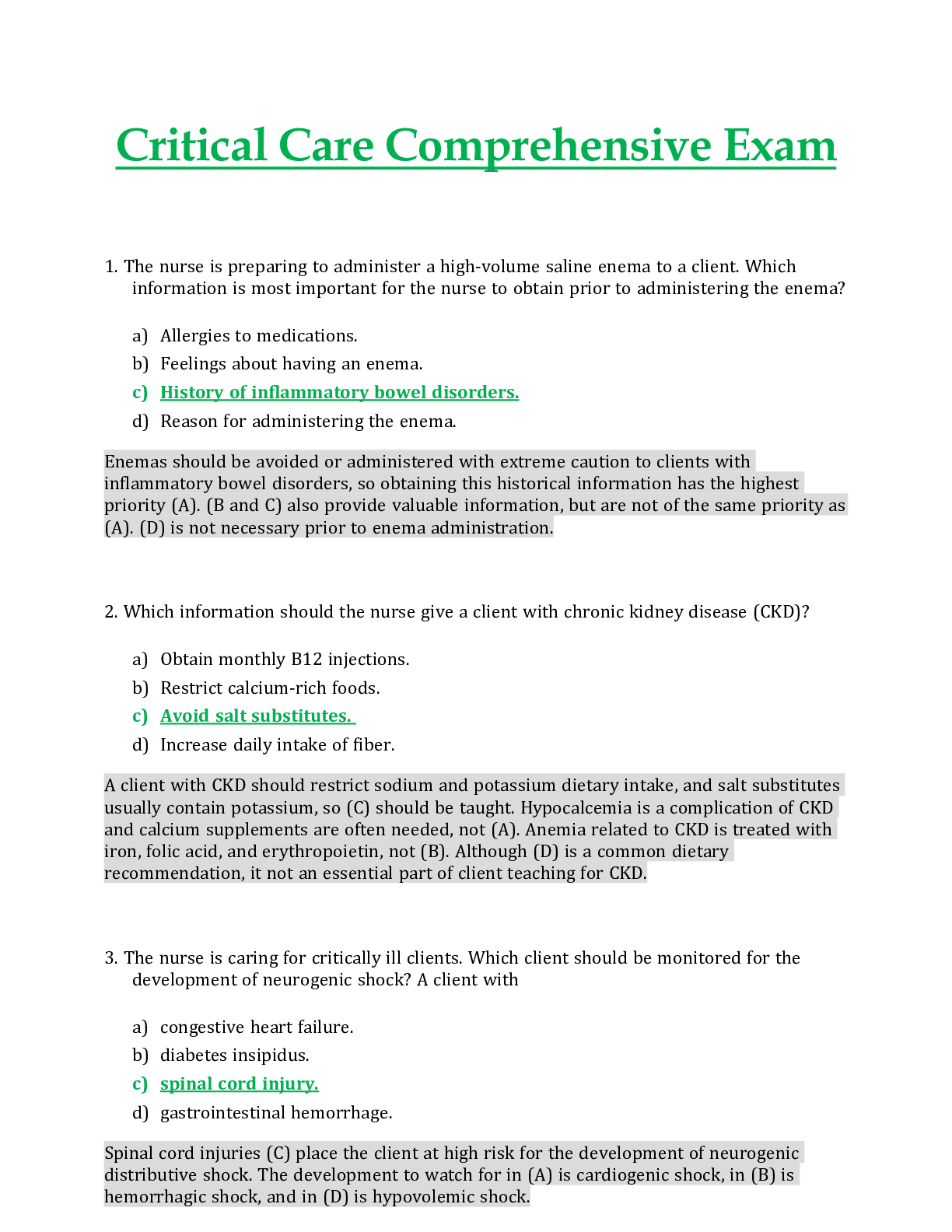
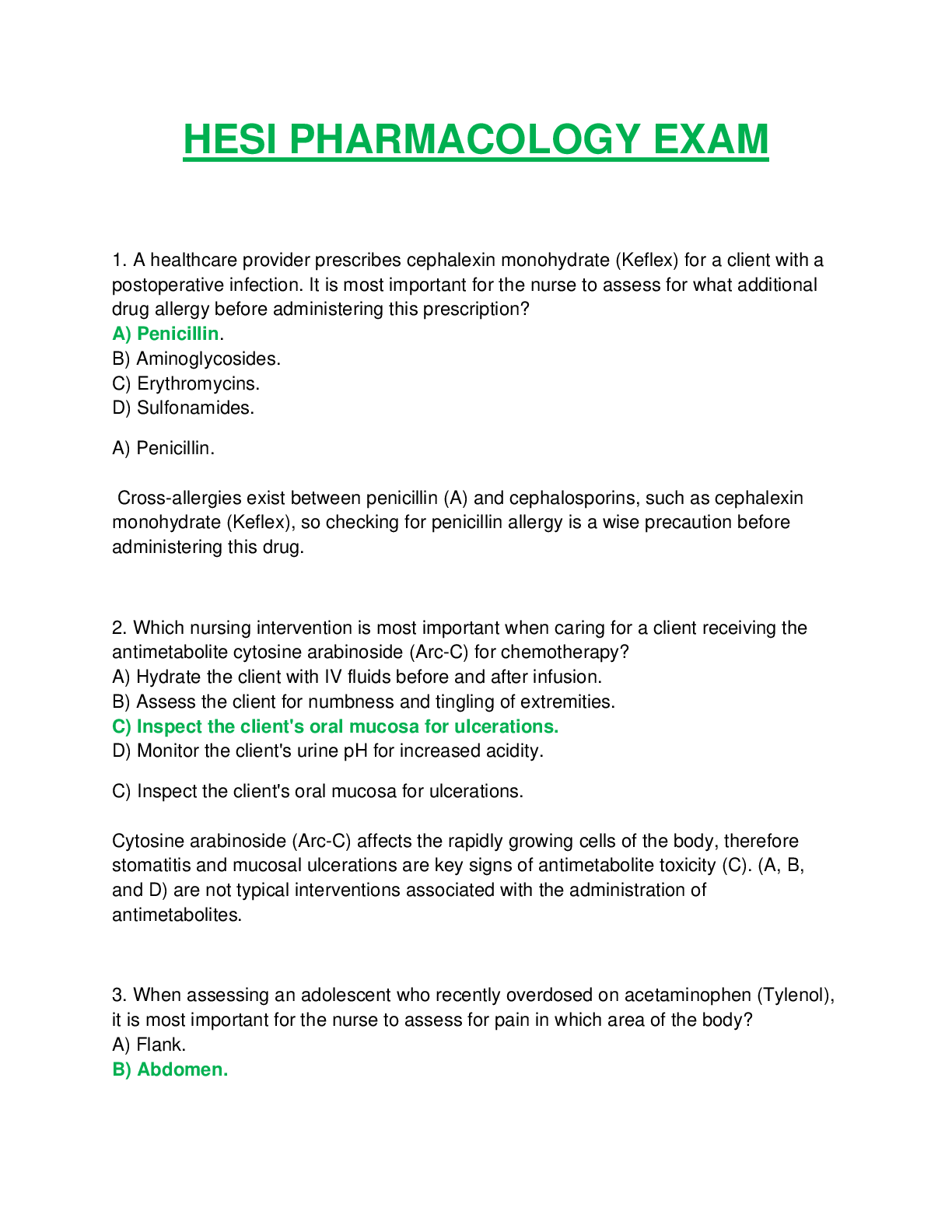
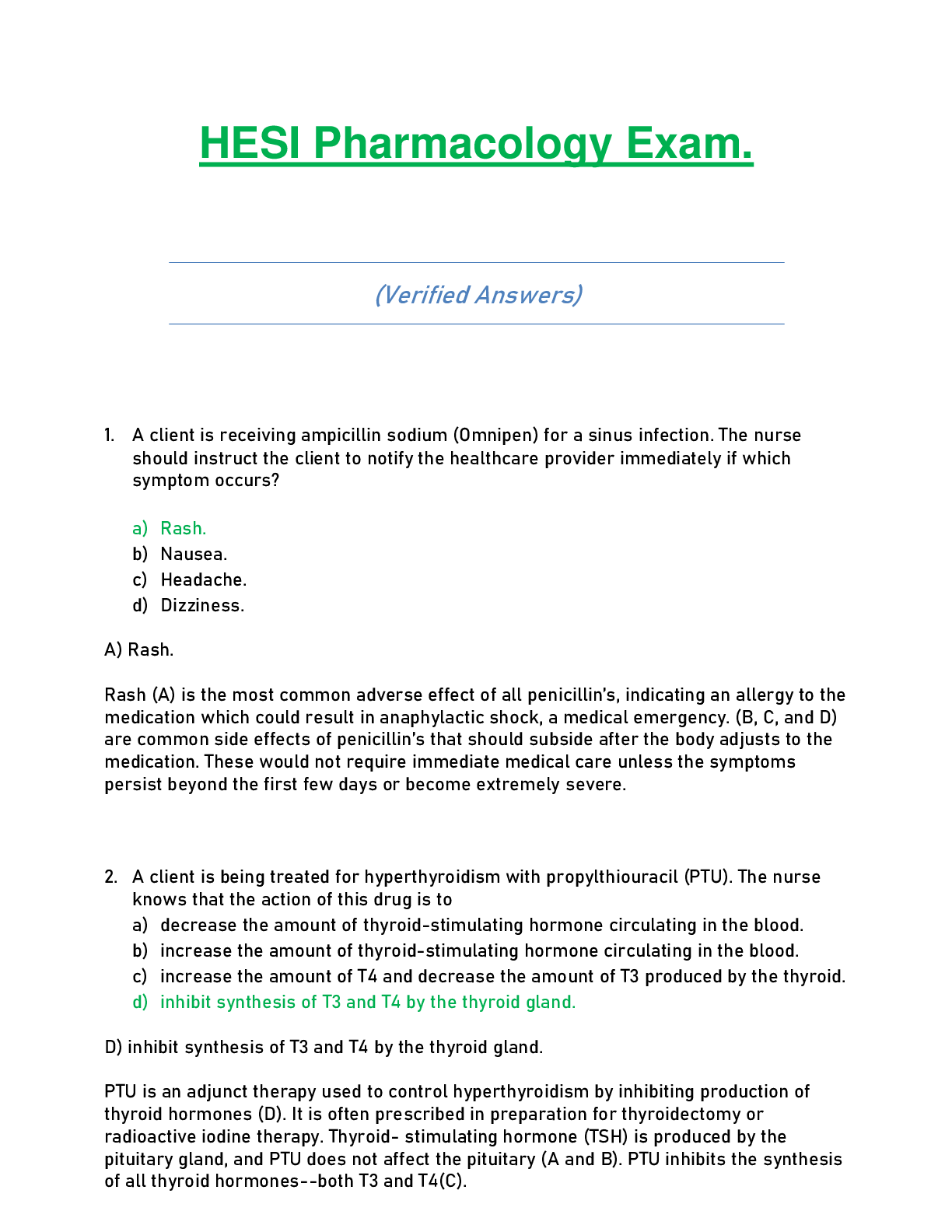
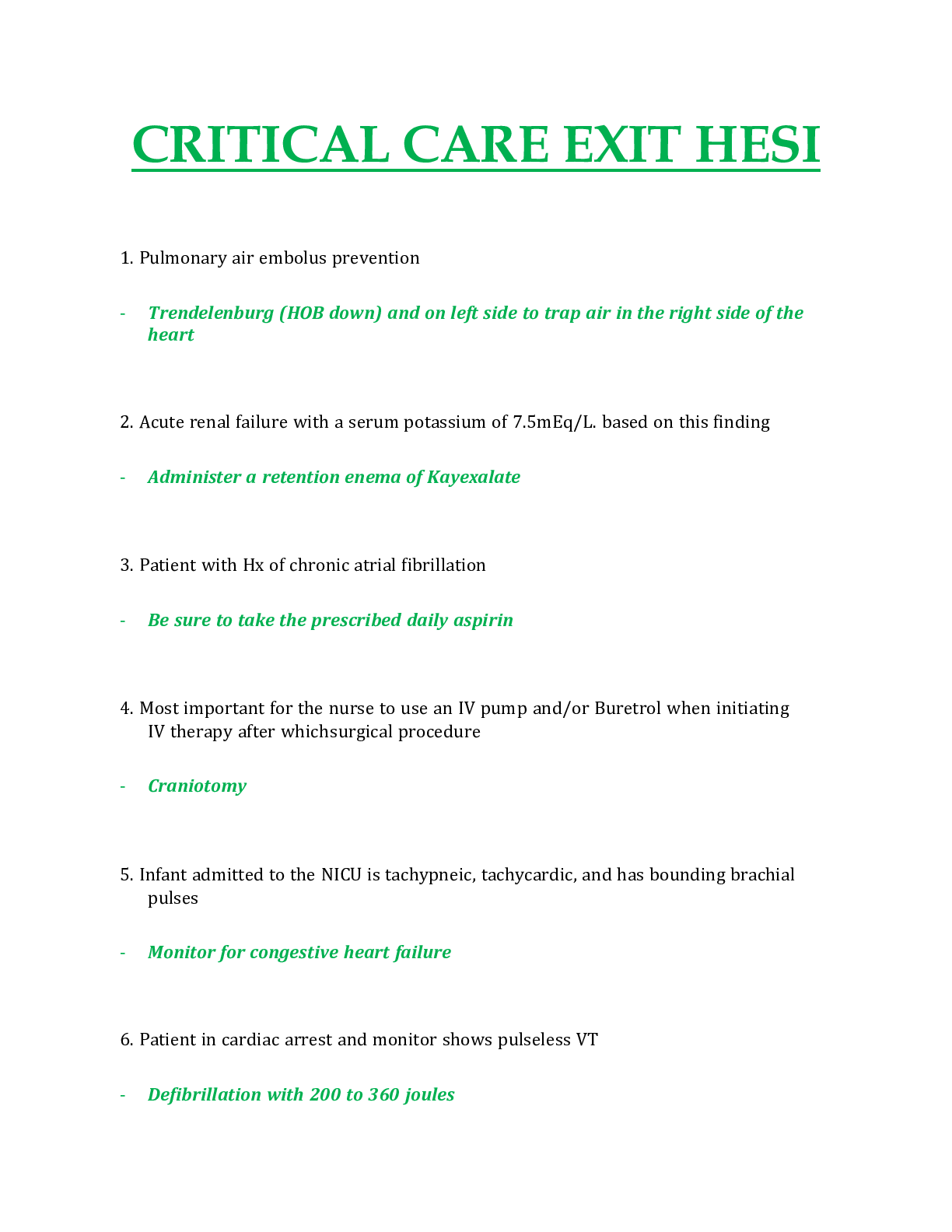
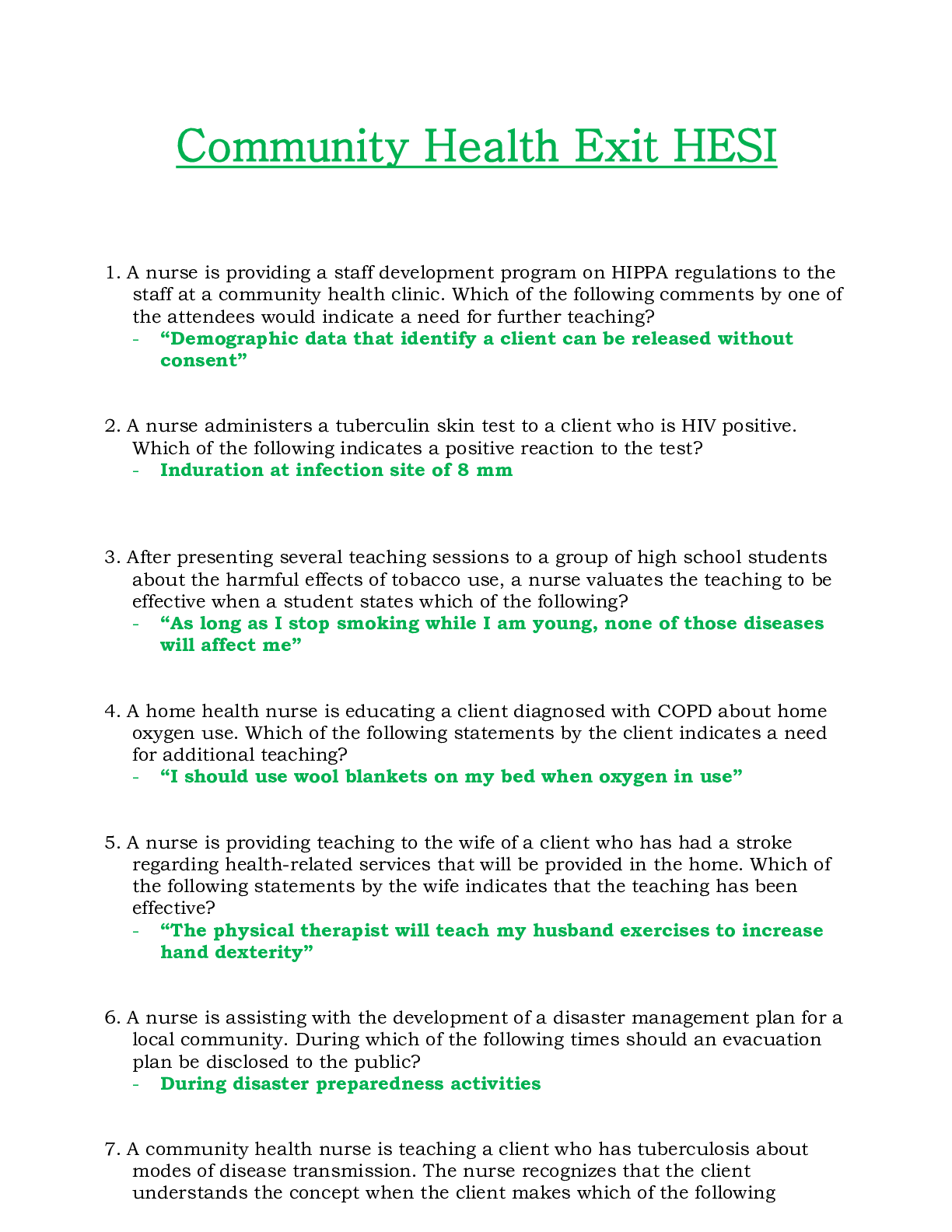
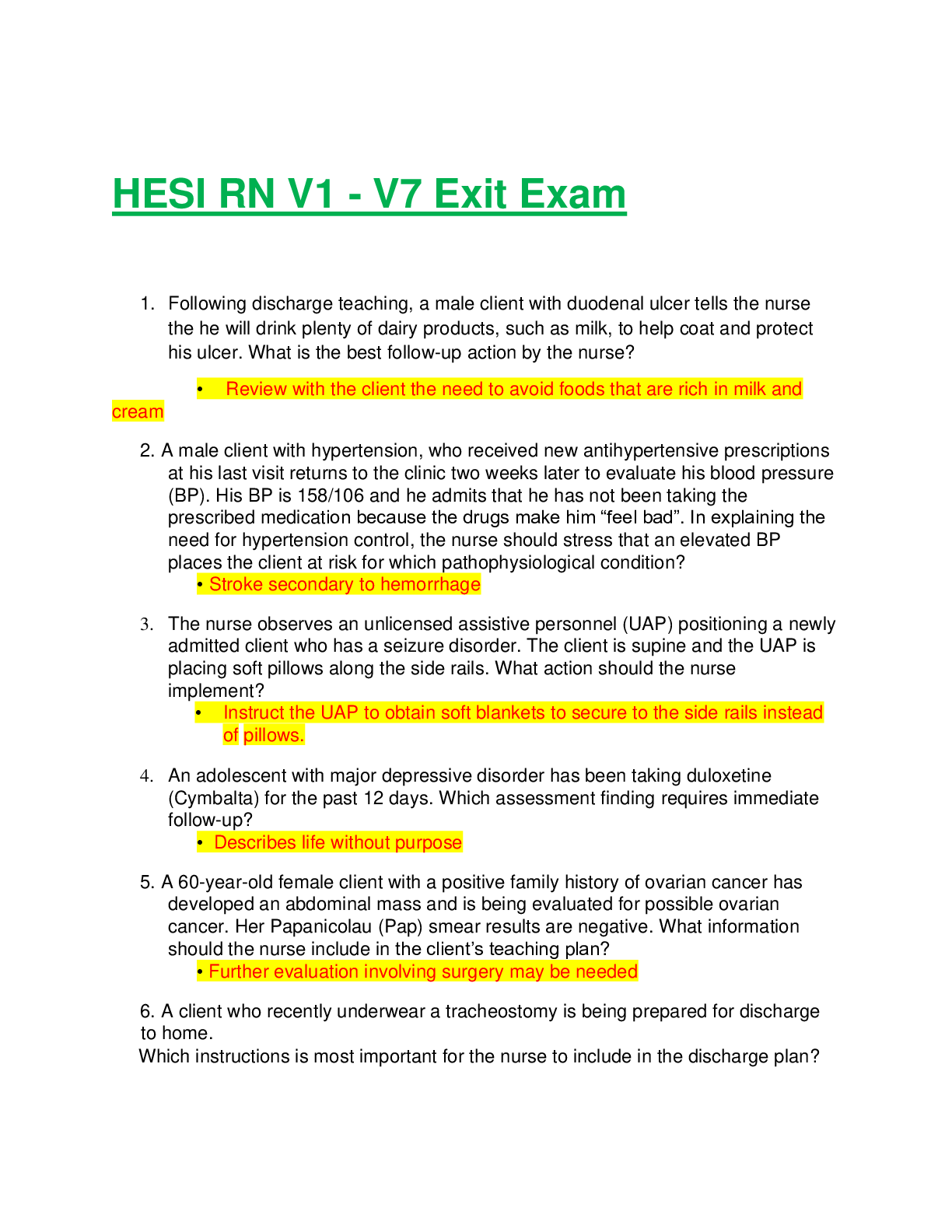
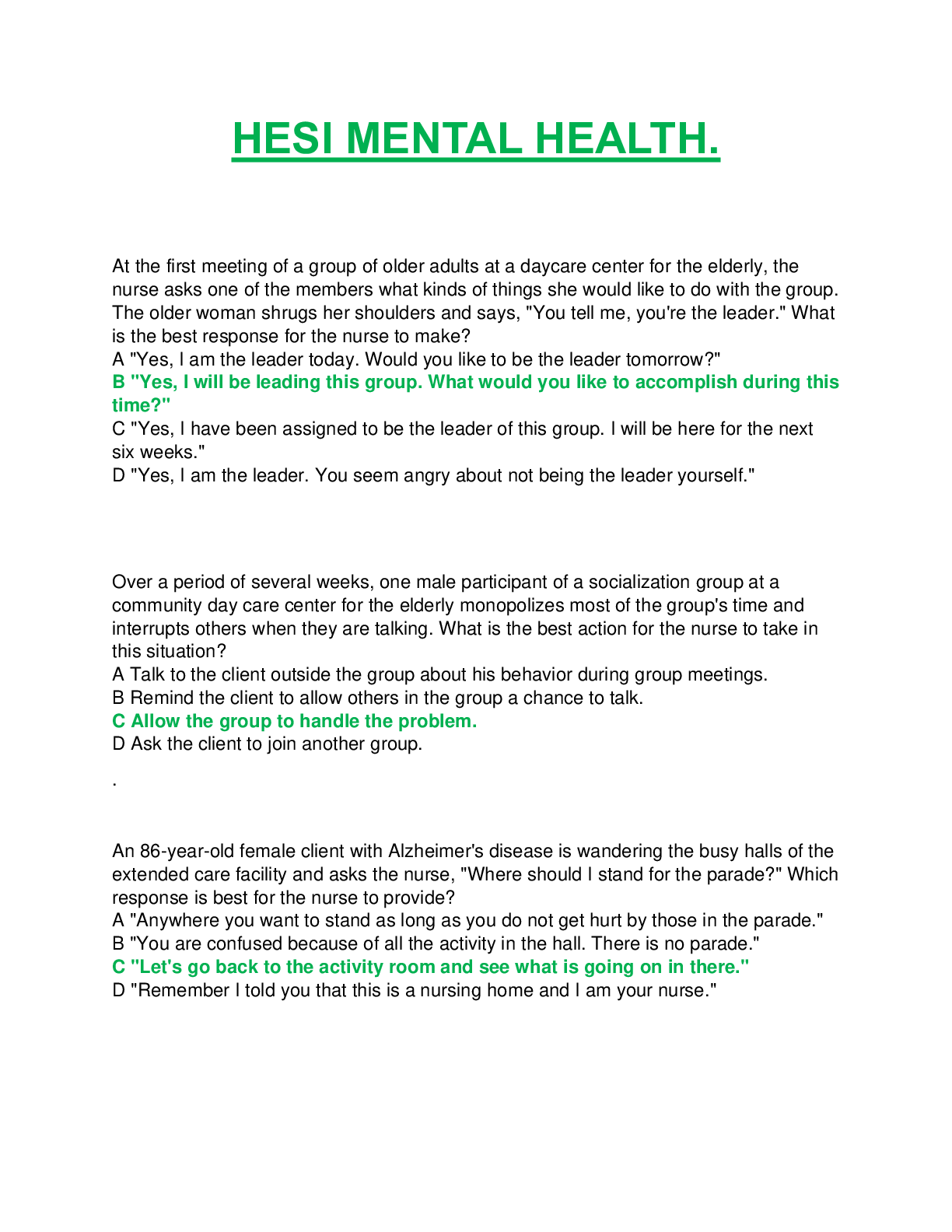
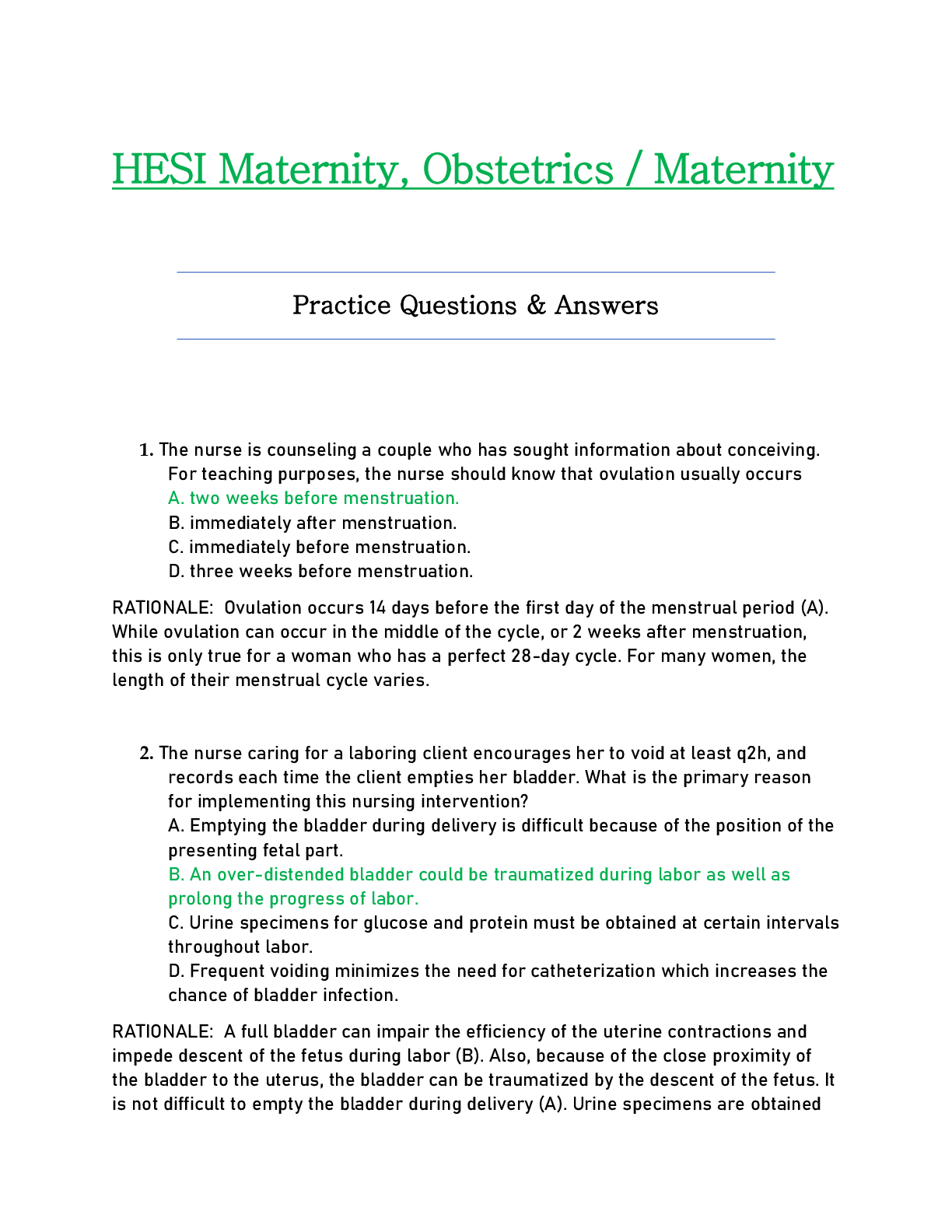
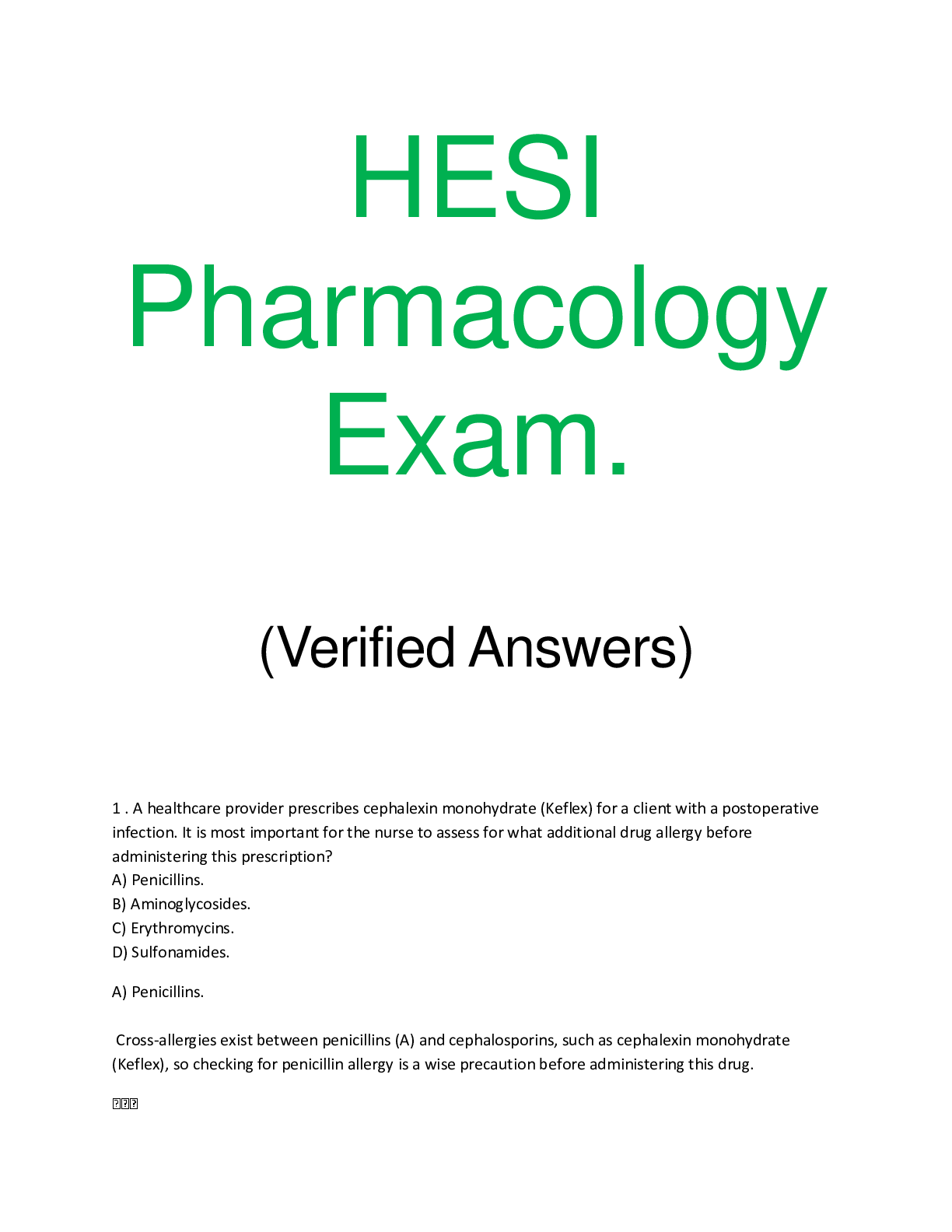
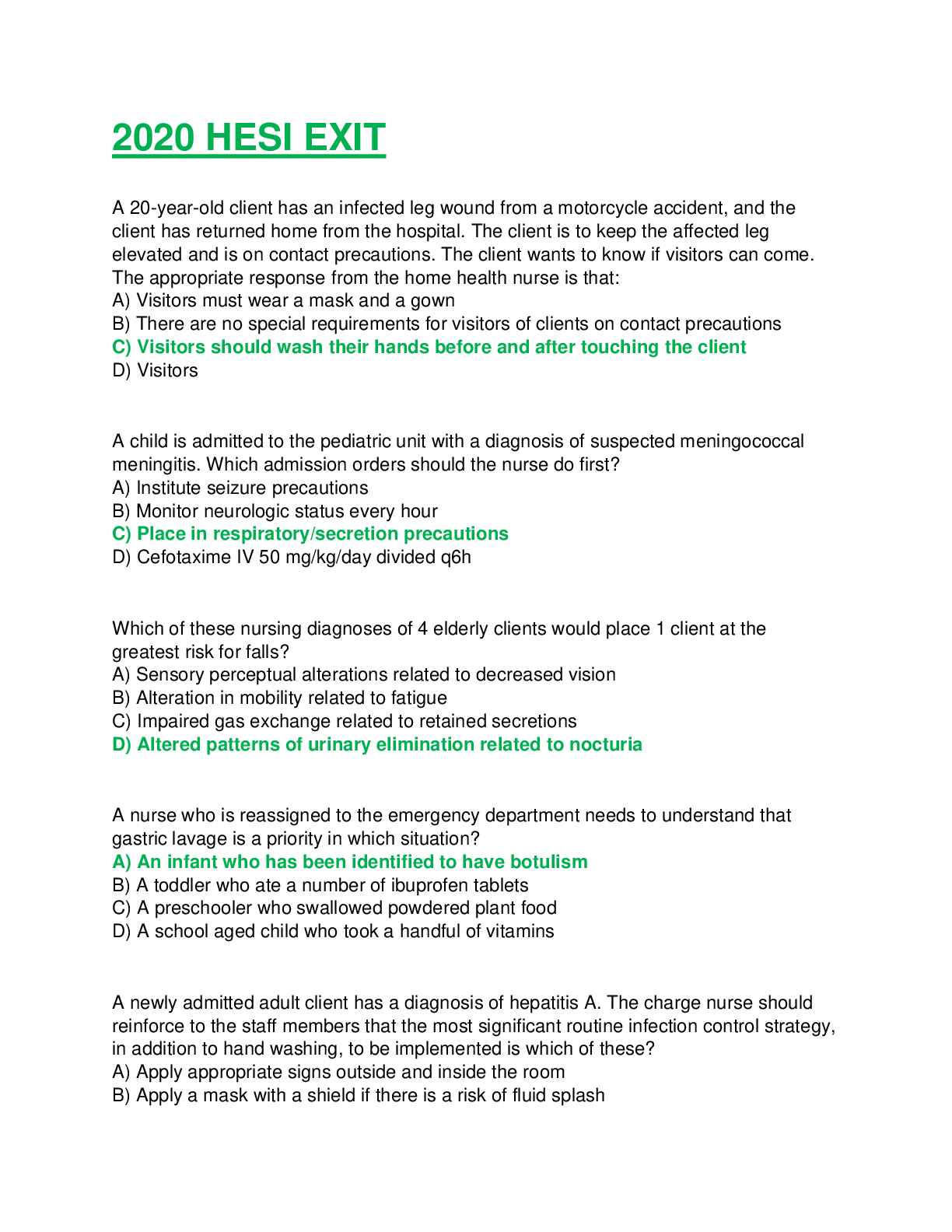
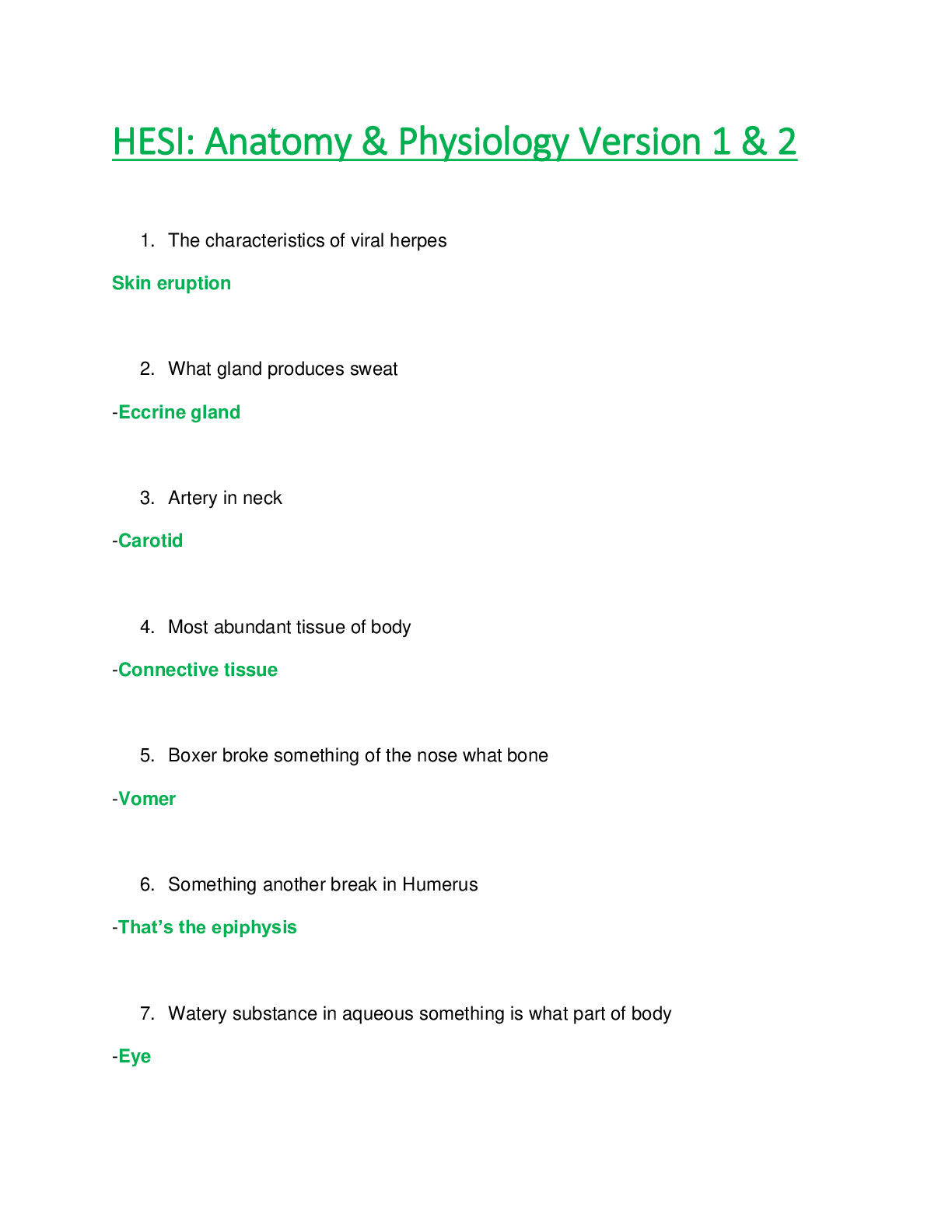







.png)

